Panda Kindergarten
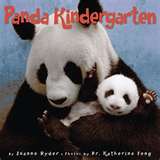 It’s back-to-school time, even for pandas. Joanne Ryder and Dr. Katherine Feng have made the world’s cutest informational book, Panda Kindergarten. The photos of the baby pandas at the Wolong Nature Reserve in China are unbearably adorable. Sixteen roly-poly panda cubs are learning the skills they will need to survive in the wild some day. No math or phonics lessons in this kindergarten class, but lots of social skills are learned as the pandas climb on the wooden structures, tumble in the snow, and even take afternoon naps together.
It’s back-to-school time, even for pandas. Joanne Ryder and Dr. Katherine Feng have made the world’s cutest informational book, Panda Kindergarten. The photos of the baby pandas at the Wolong Nature Reserve in China are unbearably adorable. Sixteen roly-poly panda cubs are learning the skills they will need to survive in the wild some day. No math or phonics lessons in this kindergarten class, but lots of social skills are learned as the pandas climb on the wooden structures, tumble in the snow, and even take afternoon naps together.
One of the Common Core State Standards in reading across all grade levels is “range of reading”. More and more, our students will be expected to read informational text and “show what they know”. One of the best ways you can help students become more fluent informational readers is to surround them with irresistible nonfiction books. Panda Kindergarten is a picture book with simple text and great photos, so it works as well for a read-aloud as any story picture book. After reading this book aloud, and pausing for the inevitable “Awwwww!’ with each photo, read the “fast facts” on the last page. “A newborn giant panda is the size of a stick of butter and weighs about four ounces…. an adult panda can weigh well over 200 pounds.” How much is four ounces? How much is a pound? Make a list of weight predictions: “I think a stapler weighs four ounces.” Bring scales into your classroom. Let students weigh and record a variety of objects to find out what else is about four ounces to get a sense of how small a newborn panda is. Students can also weigh themselves on a scale. How many students would it take to weigh about as much as an adult giant panda?
Students can also compare “panda kindergarten” and kindergarten for humans using a Venn diagram, or by writing and drawing things that are the same and things that are different. Go outside to see if your students can “swing and climb and play with their (new) friends” like panda cubs do!
To find out more about the China Conservation and Research Center for the Giant Panda at the Wolong Nature Preserve, please visit pandasinternational.org.
Read MoreIs Your Buffalo Ready for Kindergarten?
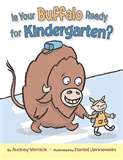 It’s August, and there’s one big question everyone has been asking: Is Your Buffalo Ready for Kindergarten? Thank goodness Audrey Vernick and Daniel Jennewein have made this fantastic book to help us find the answer. First of all, does your buffalo have a backpack? Yes? Well then, your buffalo is good to go! Tell your buffalo not to worry about being the only one in class with horns and a hump – your buffalo can be proud of being the state animal for Oklahoma! And, as author Vernick reminds us, one of the things we learn in kindergarten is that everyone is special in his or her own way.
It’s August, and there’s one big question everyone has been asking: Is Your Buffalo Ready for Kindergarten? Thank goodness Audrey Vernick and Daniel Jennewein have made this fantastic book to help us find the answer. First of all, does your buffalo have a backpack? Yes? Well then, your buffalo is good to go! Tell your buffalo not to worry about being the only one in class with horns and a hump – your buffalo can be proud of being the state animal for Oklahoma! And, as author Vernick reminds us, one of the things we learn in kindergarten is that everyone is special in his or her own way.
After you read this story to your class and get the giggles out, talk about what might happen if a real buffalo came to your school. Would it fit through the door? How big is a buffalo, anyway? Time to pull out the nonfiction! (I love tying together great picture story books with informational books, and it’s a perfect way to hit the Integrating Knowledge and Ideas Common Core State Standard.) Read a simple nonfiction book like “Buffaloes” by Marianne Johnston to your class to find out just how big these animals can be. Then, use a huge roll of paper to draw a full-sized buffalo – see if you can find a spot for him in your classroom! In the body of the buffalo, you could make a Venn diagram comparing and contrasting kids with buffaloes. Both kids and buffaloes eat plants, but only buffaloes (hopefully) chew, swallow, and regurgitate the cud to chew it again.
Find out what your state animal is, and make your own version of the book. Let students come up with what your animal needs to do or have in order to be successful in kindergarten. It’s a great way to soothe any fears about achieving this major milestone, for students and their parents as well!
Audrey Vernick, extremely awesome person and the author of this book, has a free downloadable teacher’s guide for Is Your Buffalo Ready for Kindergarten available on her website! Gotta love free! Go to audreyvernick.com to get it. Visit the illustrator, Daniel Jennewin, at danieljennewein.com. For even more buffa-loads of fun, check out their sequel: Teach Your Buffalo to Play the Drums.
Read MoreI’m Not
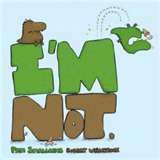 Being friends with really cool people can sometimes lead me down the “compare and despair” spiral of gloom. My husband is an artist. I’m not. One of my friends is a belly dancer. I’m not. Another friend is an organic gardener. I grow weeds. *sigh* So when I saw Pam Smallcomb’s book I’m Not with its adorable illustrations by Robert Weinstock, I knew I’d found the picture book for me. The main character (a crocodile? An alligator? A dinosaur with a little pink bow on her head?) is a bit jealous of her friend, Evelyn. “She’s not one single bit ordinary. And she’s a little mysterious. I’m not.” Evelyn is stylish, talented, energetic, and creative. (Most of my friends are Evelyns.) The croco-gator-dinosaur is not. But she makes yummy cookies, isn’t afraid of the dark, and is a good speller. Evelyn isn’t. And Evelyn needs “a true-blue friend”, which our main character most certainly is.
Being friends with really cool people can sometimes lead me down the “compare and despair” spiral of gloom. My husband is an artist. I’m not. One of my friends is a belly dancer. I’m not. Another friend is an organic gardener. I grow weeds. *sigh* So when I saw Pam Smallcomb’s book I’m Not with its adorable illustrations by Robert Weinstock, I knew I’d found the picture book for me. The main character (a crocodile? An alligator? A dinosaur with a little pink bow on her head?) is a bit jealous of her friend, Evelyn. “She’s not one single bit ordinary. And she’s a little mysterious. I’m not.” Evelyn is stylish, talented, energetic, and creative. (Most of my friends are Evelyns.) The croco-gator-dinosaur is not. But she makes yummy cookies, isn’t afraid of the dark, and is a good speller. Evelyn isn’t. And Evelyn needs “a true-blue friend”, which our main character most certainly is.
After reading I’m Not, put signs in three corners of your classroom: “I’m not”, “I am” and “I am, sometimes”. Start with a statement inspired by Smallcomb’s book: “If I were a car, I would get a speeding ticket.” Let students sort themselves into one of the three areas. Give more statements for students to sort themselves. You can turn these statements into the ice-breaker game of “Buddy Bingo” for a Self-Smart reading activity. Write the statements in squares on sheets of paper like a Bingo card. (To keep an upbeat vibe going, I’d choose all positive statements!) Tape a sheet to each student’s back, or give each student the sheet on a clipboard. Students can write their names in squares they feel describe them, but they should write only once on any sheet. See if your students can find enough different classmates to fill the squares, and let them choose one to fill in on their own page. Rather than focus on what we are not, encourage your students to focus on all that we are. I am!
For more information, please check out Pam Smallcomb’s site: pamsmallcomb.com and Robert Weinstock’s website: callmebob.com.
Read MoreGo, Go, Grapes!
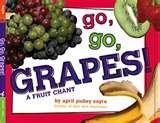 Hip, hip, hooray for April Pulley Sayre and Go, Go, Grapes! A Fruit Chant! How do you make healthy eating fun? With Sayre’s vibrant photos of fruits taken at her local farmer’s market paired with her contagious rhymes:
Hip, hip, hooray for April Pulley Sayre and Go, Go, Grapes! A Fruit Chant! How do you make healthy eating fun? With Sayre’s vibrant photos of fruits taken at her local farmer’s market paired with her contagious rhymes:
“Nectarines, tangerines,
hit the spot.
Glum? Go plum.
Or apricot!”
Start your lesson by asking students, “What do you think a mangosteen is? Or a pomegranate?” Read Go, Go Grapes! and see if your kids can discover what those uncommon words mean. Reread the book and encourage kids to chime in (“Fruit is fun!”) Next, play “Cross the Line”: have all the kids stand on one side of the classroom and imagine an invisible line down the middle of the room – or put down tape if your maintenance team won’t go bananas. Say “Cross the line if you’ve tried kiwi,” and go through the fruits listed in the book. If you have time and funds, bring in some fruits for kids to try! (Check for fruit allergies first – some kids are allergic to certain berries.) Take photos of the fruits and have kids use those Logic Smarts to sort the photos – by color, or by which they liked and which they didn’t. With all the gorgeous colors of fresh produce, you can make a “color wheel” using fruits – challenge kids to eat a rainbow! Go, Go, Grapes, hooray for healthy eating, and super job, Ms. Sayre!
For more information, visit aprilsayre.com.
Read MoreWhat to Read After a Tragedy Occurs
 Sometimes the unthinkable happens. In Aurora, Colorado, someone came into a movie theater and began shooting innocent people. Twelve people were killed, fifty-eight more were wounded. All of us are horrified by the random violence.
Sometimes the unthinkable happens. In Aurora, Colorado, someone came into a movie theater and began shooting innocent people. Twelve people were killed, fifty-eight more were wounded. All of us are horrified by the random violence.
What do we tell our children when these tragedies occur? We shield them as much as we can, but too often our kids overhear more than we’d like. How do we find the words that can make sense of the senseless?
I turned to my wise author/illustrator friend, Jean Gralley, for advice. She wrote what one reviewer called, “perhaps the best ‘crisis’ book ever published” for children: The Moon Came Down on Milk Street.
“Bad things happen in this world,” Jean wrote. “We know it; kids know it, too. When adults side-step a necessary conversation about this, lie about it or pretend it isn’t so, children realize we are being un-truthful and our discomfort only adds to their anxiety. (After Sept. 11) I instantly wanted to write and illustrate a picture book that allows adults and children a point of view and a “way in” to that conversation.
In this simple story an unnatural event gently takes place: the moon slowly, softly falls out of the sky onto a city street. When the narrator asks, “Who will make this right again?” Various voices answer, “I will!” and “We will!” and over the course of the story we watch the many helpers inventively and imaginatively repair the moon and set it back in the night sky.
In a time of natural disasters and emergencies of all kinds, kids worry. They worry about things that have happened and haven’t happened yet. It’s important we take the first steps and let them know we’re ready to listen to their thoughts, questions, and feelings, what makes them afraid. The Moon Came Down on Milk Street provides a way to enter that conversation. It also redirects the focus: yes, bad things sometimes happen. But look at all the good people coming together to make it better.”
Snuggle your children close and share The Moon Came Down on Milk Street. Talk about who came to help in the story: the doctors, nurses, fire chief, fire fighters and volunteers. Talk about who we count on in our own lives when we need help. We can focus on the one who committed an unimaginable crime, or we can be awed by the many who ran to stop the one, who helped those in need, and the brave heroes who put themselves in harm’s way to shield others.
For more information about Jean Gralley, please visit: www.jeangralley.com.
Read MorePlanting the Wild Garden
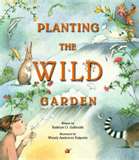 Everywhere in my yard, plants are growing, many of which I didn’t plant (some call them weeds, I call them uninvited green guests.) How do all those plants in the meadows, by the creek beds, in fields, and by the sides of roads get there? In Planting the Wild Garden written by Kathryn O. Galbraith and gorgeously illustrated by my friend Wendy Anderson Halperin, we learn that we helped those plants: “wind and water. Birds and animals. Plants and people. All of us. Together.”
Everywhere in my yard, plants are growing, many of which I didn’t plant (some call them weeds, I call them uninvited green guests.) How do all those plants in the meadows, by the creek beds, in fields, and by the sides of roads get there? In Planting the Wild Garden written by Kathryn O. Galbraith and gorgeously illustrated by my friend Wendy Anderson Halperin, we learn that we helped those plants: “wind and water. Birds and animals. Plants and people. All of us. Together.”
I love Galbraith’s easy, poetic style for nonfiction. This book doesn’t read like an old science text book, although it is bursting with information. Scotch broom seeds pop out like popcorn in the heat, cockleburs are transplanted when they catch on the fur of a fox, and dandelion seeds are blown to new places by a child. Each page is lushly and accurately illustrated by Halperin, whose award-winning project drawingchildrenintoreading.com is worth investigating if you are an educator or parent of budding readers. After reading this book aloud, give students colored pencils and paper for them to draw the seed transportation method they find most interesting. Read the book aloud twice as children draw, rereading pages students want to hear. Students can practice and demonstrate their listening comprehension through their art. Encourage them to use labels and descriptions to explain their art, and to use onomatopoeia like Galbraith did to build writing skills. Whether this is part of a science unit on plants, a celebration of Earth Day, or a lesson to build listening comprehension, Planting the Wild Garden will plant a love of nature in young learners.
For more inspiration, please visit Kathryn Galbraith’s website: kathrynogalbraith.com and Wendy Anderson Halperin’s website: wendyhalperin.com.
Read MoreAmerica the Beautiful
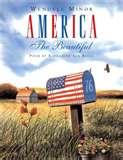 When I see the words “O beautiful for spacious skies”, I automatically sing in my head “for amber waves of grain”, but I didn’t know some of the other verses of this song that, for me, are so moving:
When I see the words “O beautiful for spacious skies”, I automatically sing in my head “for amber waves of grain”, but I didn’t know some of the other verses of this song that, for me, are so moving:
“O beautiful for heroes proved
In liberating strife,
Who more than self their country loved,
And mercy more than life!”
Katherine Lee Bates wrote the patriotic poem America the Beautiful in 1893, and Wendell Minor illustrated the verses to make the perfect book to help us celebrate our Independence Day. An introduction at the beginning of the book gives a bit of history about the poem, but the rest of the book is filled with Minor’s gorgeous paintings that bring to life the words we’ve sung for over 100 years.
Before reading the book, sing the familiar first verse of the song with students. The imagery is lovely, but may be hard for young ones to envision. What do amber waves of grain look like? Or purple mountains above the fruited plain? Ask students to do a quick draw of what the song makes them picture in their minds. Then, read aloud a bit of the introduction where we learn that Katherine Lee Bates wrote this poem after traveling from Massachusetts to Colorado. As she traveled, she wrote in her diary about the amazing, diverse landscapes she saw in our big, beautiful country. Read/sing the book once straight through with your students without stopping to comment just for the enjoyment of the book. Then, go back and revisit how the artist interpreted the poet’s words.
Minor includes in the endnotes the settings for each of his paintings. On the map in the back of the book, show students where you might see those fruited plains, those purple-shadowed mountains. Bates wrote her poem back before Alaska and Hawaii were part of our country – what might she have said about those states in her poem? Talk about your state and what its natural features look like. Have students draw and write about the beautiful state they live in, and celebrate the America in which we are so lucky to live.
Read More






